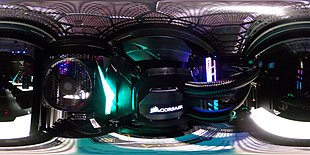Computer case
|
Housing formats |
|---|
A computer case is used to house all the components of a computer so that they are not exposed to unprotected external influences (such as dirt, water, electricity, pressure etc.)
In addition, a computer housing should shield the components to protect the environment and ensure that important components of the computer, such as the CPU and hard drives, are cooled by appropriate fans (e.g. processor coolers ). That is why computer cases are usually made of galvanized metal (SECC: Steel, electrogalvanized, cold-rolled, coil), more rarely made of hot-dip galvanized or otherwise coated sheet steel or aluminum . Since the power supply fan is no longer sufficient for more powerful PCs, many housings have brackets for installing additional fans in common frame widths between 60 mm and 140 mm.
A distinction is made between different form factors of housings. In the consumer sector, ATX and Micro-ATX are common, temporarily also BTX (used almost exclusively in finished PCs), earlier XT , AT (forerunner of ATX) and Baby-AT . These differ in the standardized components that fit into them. This is primarily the motherboard , followed by the PC power supply unit and the formats and arrangement of optional components such as drives. Some fixture specifications and dimensions share a number of the formats. With the low profile , the height of the slot cage and the matching plug-in cards differ .
Despite the specified sizes of the components, the designs of computer housings differ considerably in some cases. So there is, for example, large, high-format Big / Full-Tower , slightly lower mid-tower , flat desktop Enclosures, up to approximately pizza box large pizza box , which today, however, mainly in the professional environment as a workstation or server (usually in 19-inch Rack construction ) is used. An exception were u. a. the Apple Macintosh LC and LC II , which were designed for the home user. The current Apple Mac mini and nettop computers and other small form factor PCs sometimes have ITX format or even smaller manufacturer-specific housings, but can also only use particularly small motherboards and power supplies as well as fewer and smaller components be populated.
In a PC case there are usually several 5¼ "bays on the front for optical drives , hard disks (no longer used in this size today), tape drives and much more , as well as some 3½" bays, formerly for floppy disk drives , now for hard disks etc. The terms 5¼ "and 3½" are only derived from the respective form factors of the media. The actual width of the drives and slots is greater.
On the back there are recesses for the connections of all types of plug-in cards whose bus systems ( PCI-Express , PCI , AGP , ISA , EISA , VESA Local Bus , Micro Channel (MCA) or others) are provided by the main board and a window, which is closed with the I / O shield belonging to the main board , for the connections on the main board (e.g. for connecting a mouse, keyboard and USB devices) and a window for the power supply unit.
The housing is closed by mostly removable side walls. These have ventilation slots for the supply or exhaust air flow of the processor cooler and the graphics card. Case modding , in which the computer case is individually designed, is a fad .
In the early 1990s, a multi-digit segment display was installed in many housings , which indicated the clock frequency of the computer. However, the value of the display was set manually using a jumper . The clock frequency and display could mostly be changed with the turbo button during operation.
Screws and threads
In the case of computer housings, standardized screws are used and included in the delivery.
On PC cases, PC power supplies and 3½ " hard drives , threads for 6-32 inch screws are cut according to the Unified Thread Standard . In cases optimized for production costs, the threads must first be cut by screwing the screws into softer sheet metal.
Floppy disk drives , CD and DVD drives (except slimline drives for notebooks, nettops, etc.) have metric M3 threads . Different M3 or 6-32 screws are used from case to case for the bolts or retaining clips for the motherboard as well as for the plug-in cards. Screwless assembly is also occasionally used. The 4-40 mm screws used with D-Sub connectors are not located directly on the housing. Fans are mounted with special self-tapping screws or fan decouplers .
PC screws, including a 6-32 knurled screw and screw for fan






